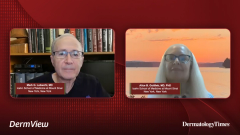
Using Bimekizumab to Manage Plaque Psoriasis
Drs Mark G. Lebwohl and Alice B. Gottlieb discuss the novel mechanism of bimekizumab and how it can change the treatment landscape for plaque psoriasis.
Episodes in this series

Mark G. Lebwohl, MD: We have a new IL-17 blocker that’s available in Japan, Canada, Europe. Unfortunately, because of some issue at the factory, the FDA didn’t approve it in the United States. This is bimekizumab, and it inhibits IL-17A and IL-17F. It’s still investigational, but the data from the pivotal trials have long ago been published. How does the dual mechanism of bimekizumab, blocking both IL-17A and IL-17F, compare with other IL-17 therapies? Is there a benefit of inhibiting both?
Alice B. Gottlieb, MD, PhD: The benefit has been shown in 2 New England Journal of Medicine articles on psoriasis. One is bimekizumab vs adalimumab and, more interesting, vs secukinumab. Bimekizumab is in both of them. I don’t want to knock secukinumab and adalimumab. They’re wonderful drugs, but secukinumab targets IL-17A alone, and bimekizumab targets both. That’s objective evidence that targeting both might be a good idea…. I’ve personally worked with bimekizumab, and in psoriatic arthritis, literally, the cripple gets up and walks. I had a patient who was heavily affected with psoriatic arthritis, with skin disease. During COVID-19, he walked 2 miles to get his bimekizumab shot for the clinical trial. He couldn’t do that before. I had another lady who had big, swollen, hot tender knees, and it disappeared. She was right: I changed her life. This is the power of clinical trial and the power of this drug. There’s something to it. But the most objective data are in the New England Journal of Medicine.
Mark G. Lebwohl, MD: Let’s put some numbers behind what you said because that’s absolutely true. In the BE SURE study, 90.8% of patients achieved PASI [Psoriasis Area and Severity Index] 90, and 68.2% achieved PASI100, with no psoriasis left. That’s the first drug I’m aware of that, at the end of the pivotal trial—a placebo-controlled period—the majority of patients achieved PASI100. It’s extraordinary. What do the numbers suggest about the role this agent could potentially play in the treatment spectrum? You already mentioned psoriatic arthritis. We have a drug that’s highly effective for both.
Alice B. Gottlieb, MD, PhD: The psoriatic arthritis data have been publicly presented, so I can talk about them. In terms of efficacy, they chose a higher end point. They chose ACR [American College of Rheumatology] 50, which is much more stringent than an ACR20, and they were equal in the joints. However, in the skin, roughly 60% of those patients with psoriatic arthritis achieve PASI100. it’s unheard of in the skin. It’s even more unheard of in the rheumatology world. Patients do care, even though on average, psoriatic arthritis patients may have less skin body surface area. They care as much and want to be clear. I’m excited about having it for psoriasis. I’m at least as excited about having it for psoriatic arthritis. It’s in clinical trials for Hidradenitis suppurativa, and I’m smiling because I’m looking forward to getting it for that disease too. It’s a wonderful drug. I’m looking forward to getting it. I have many patients telling me that I’ve changed their life.
Transcript Edited for Clarity
Newsletter
Like what you’re reading? Subscribe to Dermatology Times for weekly updates on therapies, innovations, and real-world practice tips.





















